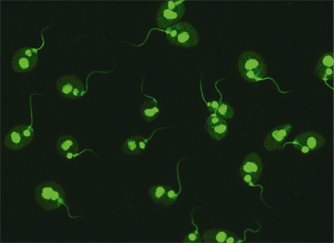IIFT
cell nuclei
(ANA global test)
HEp-2 cells
liver
(2 BIOCHIPs per field)
human
monkey
IIFT
cell nuclei (ANA) EUROPattern
cell nuclei (ANA)
HEp-2 cells
liver
(2 BIOCHIPs per field)
human
monkey
IIFT
cell nuclei
(ANA global test)
HEp-20-10 cells
liver
(2 BIOCHIPs per field)
human
monkey
IIFT
cell nuclei (ANA) EUROPattern
cell nuclei (ANA)
HEp-20-10 cells
liver
(2 BIOCHIPs per field)
human
monkey
IIFT
cell nuclei (ANA) EUROPattern
mitochondria (AMA)
HEp-20-10 cells
kidney
(2 BIOCHIPs per field)
human
rat
IIFT
cell nuclei (ANA)
HEp-2 cells
human
IIFT
cell nuclei (ANA)
EUROPattern
HEp-2 cells
human
IIFT
cell nuclei (ANA)
HEp-20-10 cells
human
IIFT
cell nuclei (ANA)
EUROPattern
HEp-20-10 cells
human
ELISA
histones
antigen-coated
microplate wells
IIFT
antibodies against cell nuclei
(ANA control), homogeneous pattern
ELISA
double-stranded DNA
(dsDNA)
antigen-coated
microplate wells
ChLIA
IDS dsDNA IgG 1
antigenic coated magnetic particles
IIFT
antibodies against dsDNA
(dsDNA ab control)
ELISA
dsDNA-NcX
antigen-coated
microplate wells
IIFT
dsDNA
flagellates
Crithidia luciliae
IIFT
dsDNA
EUROPattern
flagellates
Crithidia luciliae
IIFT
dsDNA (sensitive)
flagellates
Crithidia luciliae
IIFT
dsDNA (sensitive)
EUROPattern
flagellates
Crithidia luciliae
ELISA
nucleosomes
antigen-coated
microplate wells
ChLIA
IDS ANA Control Set 1
3 x 1.5mL Control 1/2
EUROLINE
Anti-ENA ProfilePlus 1
(nRNP/Sm, Sm, SS-A, Ro-52, SS-B,
Scl-70, Jo-1 separately)
EUROLINE
EUROLINE
ANA Profile 23
(nucleosomes, dsDNA, histones, SS-A, Ro-52,
SS-B, nRNP/Sm, Sm, Mi-2 alpha, Mi-2 beta, Ku, CENP A,
CENP B, Sp100, PML, Scl-70, PM-Scl100, PM-Scl75,
RP11, RP155, gp210, PCNA, DFS70 separately)
EUROLINE
EUROLINE
ANA Profile 3
(nRNP/Sm, Sm, SS-A, Ro-52, SS-B, Scl-70, PM-Scl,
Jo-1, CENP B, PCNA, dsDNA, nucleosomes,
histones, ribosomal P-proteins, AMA M2 separately)
EUROLINE
EUROLINE
ANA Profile 3 plus DFS70
(nRNP/Sm, Sm, SS-A, Ro-52, SS-B, Scl-70, PM-Scl,
Jo-1, CENP B, PCNA, dsDNA, nucleosomes, histones,
ribosomal P-proteins, AMA M2, DFS70 separately)
EUROLINE
EUROLINE
ANA Profile et Mi-2 et Ku
(Mi-2, Ku, nRNP/Sm, Sm, SS-A, Ro-52, SS-B, Scl-70,
PM-Scl, Jo-1, CENP B, PCNA, dsDNA, nucleosomes,
histones, ribosomal P-proteins, AMA M2 separately)
EUROLINE
EUROLINE
dsDNA, nucleosomes, histones, DFS70
EUROLINE
EUROLINE
ANA Profile et Mi-2, Ku, DFS70
(Mi-2, Ku, nRNP/Sm, Sm, SS-A, Ro-52, SS-B, Scl-70,
PM-Scl100, Jo-1, CENP B, PCNA, dsDNA,
nucleosomes, histones, ribosomal P-proteins,
AMA M2, DFS70 separately)
EUROLINE
EUROLINE
Cytoplasm profile
(AMA M2, M2-3E, ribosomal P-proteins, Jo-1
SRP, PL-7, PL-12, EJ, OJ, Ro-52 separately)
EUROLINE
EUROLINE
ANA Profile 5
(nRNP/Sm, Sm, RNP70, RNPA, RNPC, SS-A,
Ro-52, SS-B, Scl-70, PM-Scl, Jo-1, CENP B,
PCNA, dsDNA, nucleosomes, histones,
ribosomal P-proteins, AMA M2 separately)
EUROLINE
EUROLINE
ANA Profile 1
(nRNP/Sm, Sm, SS-A, Ro-52, SS-B, Scl-70,
Jo-1, CENP B, dsDNA, nucleosomes, histones,
ribosomal P-proteins separately)
EUROLINE
ELISA
Sm
antigen-coated
microplate wells
ChLIA
IDS Sm 1
antigenic coated magnetic particles
ELISA
ribosomal P-proteins
antigen-coated
microplate wells


















 Various test methods are available for the routine detection of antibodies against dsDNA: enzyme immunotests such as ELISA or EUROLINE and the Crithidia luciliae immunofluorescence test (CLIFT) The various test systems differ, sometimes greatly, regarding their sensitivity and specificity. The conventional CLIFT, for example, shows a particularly high disease specificity, while the IIFT Crithidia luciliae sensitive was developed with a focus on high sensitivity.
Various test methods are available for the routine detection of antibodies against dsDNA: enzyme immunotests such as ELISA or EUROLINE and the Crithidia luciliae immunofluorescence test (CLIFT) The various test systems differ, sometimes greatly, regarding their sensitivity and specificity. The conventional CLIFT, for example, shows a particularly high disease specificity, while the IIFT Crithidia luciliae sensitive was developed with a focus on high sensitivity.